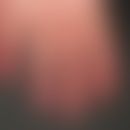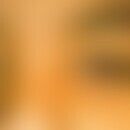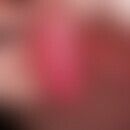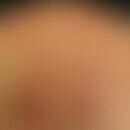Synonym(s)
HistoryThis section has been translated automatically.
DefinitionThis section has been translated automatically.
Frequent, benign, HPV-induced, regressive papillomas on skin and/or mucous membranes, whose clinical aspect ranges from smallest, flat, barely visible papules to cauliflower-like growths the size of a palm, depending on the duration of existence and localization.
You might also be interested in
PathogenThis section has been translated automatically.
Human papilloma virus (HPV), see human papilloma viruses. At present there are more than 120 different types of virus. The incubation period is between 1 and 8 months.
ClassificationThis section has been translated automatically.
Depending on the localization and the clinical aspect, a distinction is made between HPV-induced warts:
- Warts on keratinizing epithelium:
- Warts on non-keratinizing epithelium (mucous membranes):
- Condylomata acuminata
- Condylomata gigantea (Buschke-Löwenstein)
- Hyperplasia, focal epithelial (M. Heck)
- Bowenoid papulosis.
- Special clinical forms:
- Verruca paronychialis
- Verrucae subungualis
- Butcher's warts
- Warts between the toes.
.
Occurrence/EpidemiologyThis section has been translated automatically.
Viral warts occur mainly in children and adolescents. In children, most papillomas heal spontaneously within months of the initial infection, regardless of treatment. Infection is most common in the second decade of life and affects over 40 % of children (Bristow I 2023).
EtiopathogenesisThis section has been translated automatically.
ClinicThis section has been translated automatically.
TherapyThis section has been translated automatically.
There are numerous therapeutic modalities for HPV-induced warts, often determined by the clinical experience of the therapist. Of critical importance to the effectiveness of treatment is a reliable diagnosis. Although HPV-induced wart disease is of great clinical importance, studies regarding the efficacy of individual therapeutic modalities are scarce. Furthermore, the type of virus plays an important role for the prognosis. This prognostic factor is considered in very few studies. Likewise, the increasing duration of the disease significantly influences its prognosis. This increases the risk of tolerance induction and thus persistence of the warts.
Important for the efficiency of a wart therapy is a strategy individually adapted to the patient (and consented with the patient), as well as the qualified assessment and determination of the therapy goal.
Individual therapy goals (varies according to Rübben):
- Targeted surgical intervention (see under surgical therapy)!
- Deliberate abandonment of therapeutic measures in wart diseases that are expected to heal spontaneously (in children, high spontaneous remission rate - >60% within 2 years; in this respect, non-intervention may also be a justified option in the absence of suffering).
- Repetitive destructive reduction of the wart mass with the aim of protracted healing
- Repetitive destructive reduction of wart mass with no prospect of healing (e.g., in generalized verrucosis).
- Activation of the immune system (e.g. Imiquimod)
- Pseudotherapies/placebo measures (under placebo, healing after 4-24 weeks was 27% in a study in children and adults).
Therapeutic study results of wart therapies are inevitably influenced by the factor "personal experience" of the authors and therefore only of low evidence. According to the criteria of evidence-based medicine, sufficient data are only available for the topical application of salicylic acid (!). Cryotherapy was shown to be equivalent in 2 studies.
General therapyThis section has been translated automatically.
In principle, a keratolytic treatment will be an essential part of the overall therapeutic package for every treatment modality. Ideally, a salicylic acid patch (e.g. Guttaplast) should be applied for 6-12 hours under occlusion. The patch should be removed immediately before an additional treatment method (e.g. curettage). Only in this way can the full keratolytic effect of the salicylic acid be utilized.
External therapyThis section has been translated automatically.
The following topicals and procedures are suitable for wart therapy:
Medicinal procedures:
- 0.5% 5-Fluorouracil-Lsg. and 10% salicylic acid (e.g. Verrumal Lsg.):
- Method of application: Apply 2-3 times/day over approx. 6 weeks to affected areas. Important: Remove the varnish film before each new application. The horny layer should also be carefully rubbed off with a curette (alternatively: small sharp scissors) before applying the therapeutic agent (this procedure can be carried out by the patient himself). After successful therapy, continue treatment for 1 week. A slight burning sensation occurs as a side effect. The combination of 5-fluorouracil and salicylic acid has been proven to be an effective and useful therapy (evidence level I) if carried out properly (compliance!).
- Alternative: 5% imiquimod cream(Aldara® - not approved!): 3-5 times/week after careful sharp curettage (can also be carried out by the patients themselves or their relatives after prior instruction) of the wart, apply Imiquimod thinly. The treated area should be carefully bandaged. Good success rates can be achieved with this procedure!
- Alternative: Podophyllin/ Podophyllotoxin: contained in formulations of various wart tinctures (e.g. Condylox Lösung®) or wart ointments (Wartec-Creme®).
- Alternative: glacial acetic acid-nitric acid-lactic acid solution(Solco Derman®): brush the affected area once a week (this therapy should not be used by patients!). Side effects are burning and redness.
- Alternative: Dithranol/salicylicacid: creams containing dithranol/salicylic acid, e.g. wart ointment InfectoPharm or wart ointment as a magistral formulation (NRF 11.31.), apply once/day to the affected areas (preferably overnight under a quick bandage). In the case of periungual infestation , it is advisable to apply a colorless nail polish to the nail; this prevents yellowing of the nail). Caution! Irreversible yellow discoloration of laundry and sanitary facilities on contact with the dithranol it contains
- Alternative: Cantharidin (e.g. Canthacur-PS = combination preparation with cantharidin, podophyllin and salicylic acid; only available from international pharmacies): Application of the solution, after drying dressing with topical glucocorticoids under occlusion (foil). Formation of a painful blister, which is carefully curetted under local anesthesia. In case of periungual infestation, cut away the nail above the wart.
- Experimental: Bleomycin: Dilute bleomycin in 0.9% NaCl solution of 0.1-1.0 IU/ml and inject intralesionally. Use only for stubborn warts. Caution! Caution when applying to the acres: Do not use in vascular diseases, as transient vasospasms may occur.
- Experimental: Single sublesional injection of 4.5 MU interferon alfa-2a
Physical methods:
- WIRA: Water-filtered infrared therapy: 3 times/week over several weeks in combination with removal of the keratinized part of the wart after application of keratolytic external agents (e.g. Guttaplast).
- Photodynamic therapy (5-aminolevulinic acid): The therapy results reported in various studies vary. The therapy results reported in various studies vary. The therapy appears to be effective. see also Photodynamic therapy, Indication
Internal therapyThis section has been translated automatically.
Immunomodulation is in the foreground. Accompanying application in case of extensive findings and after completed surgical therapy or in case of recurrent verrucae or for prophylaxis. Cave! U.U. cost-intensive therapy!
- Interferons: Interferon alfa-2a in more than 2 relapses (Roferon A), 3-10 million IU/day 3 times/week s.c. over 6 weeks. Interferon beta (e.g. fiblaferon) intralesional or systemic with three 14-day treatment cycles, at 4-week intervals. 3 times/week 1-3 million IU interferon beta i.v., total dose of max. 81 million IU. (Note: The therapeutic principle has not been established and is considered obsolete).
- Acitretin: 10-25mg p.o./day. (Note: The therapeutic principle has not been established and is considered obsolete).
- Levamisole: In a controlled double-blind study, the success of treatment with levamisole (e.g. Ergamisol) was documented. Levamisol was administered on 3 consecutive days every 14 days for 5 months at a dose of 5 mg/kg bw/day.
Operative therapieThis section has been translated automatically.
The so-called rotation therapies have proven themselves: alternating curettage, icing, laser, acidic tinctures (Duofilm, Verrumal, Verrucid) and immunostimulating measures.
- Curettage: removal of the superficial part of the verrucae, if possible without deeper injury to the papillary body after previous hourly keratolysis (see below). Deep excisions are obsolete today due to the high recurrence rate of about 80%. In principle, removal in several sessions without local anaesthesia or with icing with liquid air or after 4-6 hours of application of an anaesthetic cream under occlusion (e.g. EMLA cream) is indicated.
- Keratolysis and/or curettage (vulgar warts): Softening of the wart with salicylic acid-containing plasters (guttaplast), fixation for 24-48 hours, followed by careful removal after icing with nitrogen spray, either with a sharp spoon or the ring curette. Hemostasis by cauterization (has the positive side effect of also inactivating the viruses in the vicinity), dabbing with iron III chloride solution (10% CSF ferrisesquichlorate) or polycresulene solution(Albothyl Lsg.). Then apply podophyllotoxin solution (Condylox Lsg.), lactic acid, acetic acid and/or salicylic acid containing tinctures (Verrucid), if necessary etching with silver nitrate (Höllenstift).
- Ablative laser: removal of warts by CO2- Neodymium-YAG-Laser or Erbium-Laser with simultaneous hemostasis, also inactivation of viruses in the neighbourhood. Meta-analyses (2149 patients) showed different response rates for the laser types: CO2 laser (50-100%), neodymium-YAG laser (50-100%), erbium-YAG laser ( 72-100%) (Nguyen 2016).
- Dye laser: Studies have shown successful application of pulsed dye laser after ablation of the horny layer (response rates 47-100%).
- Cryosurgery: Cryosurgical removal with liquid nitrogen (closed with a stamp or open as a spray procedure after covering the surrounding area with moulage, especially on the fingers). Creation of a subepidermal blister which dries up after 7-14 days and heals secondarily. Caution! Painfulness.
General wound treatment: in case of larger secondary healing defects, careful wound treatment with antibacterial ointments (e.g. ointments containing polyvidon iodine or antibiotics) and fatty gauze (e.g. Oleo-Tuell, Jelonet) should be carried out. As an alternative to ointments, drying, disinfecting solutions or compresses soaked in solution can be used, e.g. methylrosanilinium chloride solution (gentian violet: if necessary, moisten compresses with gentian violet every 3 hours). Furthermore: foot baths with disinfectants such as quinolinol (e.g. quinosol 1:1000 or rp. 042 ) or polyvidon iodine solution (e.g. Betaisodona solution, rp. 203 ) are used daily from the 2nd - 3rd postoperative day to remove the bandages. Caution! Good drying before applying a new dressing is necessary.
Progression/forecastThis section has been translated automatically.
The patient should always be informed, also about the high recurrence rate. Attention should be drawn to the following prognostically unfavourable factors (n. Rübben):
- advanced age (>29 years)
- Long duration > 2 years
- Multiple warts (> 5)
- Large warts (> 2,0 cm)
- Pronounced horn overlapping of the warts
- Periungual, palmar or plantar localization
- Acrocyanosis with acral localization
- Associated cellular or humoral immunodeficiency
- onset of the disease during disease-related or iatrogenic immunosuppression
- Resistance to therapy with previous adequately performed treatments
ProphylaxisThis section has been translated automatically.
NaturopathyThis section has been translated automatically.
Thuja extracts (see below occidental tree of life, see below Thuja summitates the extract from the tips of the tree of life): Mono- or combination therapy for internal and/or external therapy (Thuja Lsg. and/or Thuja Drg.). Brush Thuja solution several times a day on the affected area until it heals. Thuja Drg. starting with 1 Drg. p.o. 3 times/day and slowly increasing to 6 Drg./day until healing.
s.a. Chelidonii herbae, s.a. Tea, green, Podophyllii Rhizoma
s.a. Dandelion, common
see also under Sandalwood, tea tree oil
Note(s)This section has been translated automatically.
LiteratureThis section has been translated automatically.
- Bristow I (2023) Paediatric Cutaneous Warts and Verrucae: An Update. Int J Environ Res Public Health 19:16400.
- Ciuffo G (1907) Imnesto positiv con filtrado di verrucae volgare. Giorn Ital Mal Venereol 48: 12-17
- Elsner P (2003) New procedure set on special infrared light. Warts painlessly irradiated off? MMW Fortschr Med 145: 18
- Insinga RP et al. (2003) The health and economic burden of genital warts in a set of private health plans in the United States. Clin Infect Dis 36: 1397-1403
- Kopera D (2002) Verrucae vulgares. Treatment with 585 nm flashlamp pumped pulsed dye laser. Dermatology 53: 604-607
- Leman JA, Benton EC (2000) Verrucas. Guidelines for management. Am J Clin Dermatol 1: 143-149
- Nguyen J et al.(2016)Laser Treatment of Nongenital Verrucae: A Systematic Review. JAMA Dermatol 152:1025-1034.
- Rübben A (2011) Clinical algorithm for the treatment of cutaneous, extragenital HPV-induced warts. Dermatology 62: 6-16
- Shelly WB et al. (1991) Intralesional bleomycin sulfate therapy for warts. A novel bifurcated needle puncture technique. Arch Dermatol 127: 234-236
- Skinner RB Jr (2003) Imiquimod. Dermatol Clin 21: 291-300
- Toro JR et al. (2003) Topical cidofovir for the treatment of dermatologic conditions: verruca, condyloma, intraepithelial neoplasia, herpes simplex and its potential use in smallpox. Dermatol Clin 21: 301-309
- Tucker SB et al. (2003) Plantar wart treatment with combination imiquimod and salicylic acid pads. J Drugs Dermatol 2: 70-72
- Zhu P et al. (2022) Clinical guideline for the diagnosis and treatment of cutaneous warts (2022). J Evid Based Med 15:284-301.
- Zschocke I et al. (2004) Efficacy and benefit of a preparation containing 5-FU/salicylic acid in the treatment of vulgar and plantar warts - systematic literature review and meta-analysis. JDDG 3: 187-193
Incoming links (28)
Chelidonii herba; Drosera herba; Erbium yag laser; Erythrokeratodermia progressive, type burns; Fluorouracil; Garden spurge milk; Inclusion nipples; Methylrosanilinium chloride solution, aqueous 0,1/0,5 % (nrf 11.69.); Mucosal warts; Podophylline; ... Show allOutgoing links (50)
Acitretin; Acrocyanosis; Acuminate condyloma; Bleomycin; Bowenoids papulose; Butcher warts; Cantharidine; Chelidonii herba; Cryosurgery; Dandelion, ordinary; ... Show allDisclaimer
Please ask your physician for a reliable diagnosis. This website is only meant as a reference.




